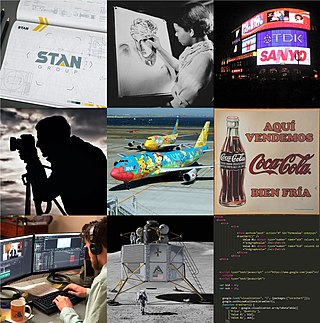Related Research Articles

Graphic design is a profession, academic discipline and applied art whose activity consists in projecting visual communications intended to transmit specific messages to social groups, with specific objectives. Graphic design is an interdisciplinary branch of design and of the fine arts. Its practice involves creativity, innovation and lateral thinking using manual or digital tools, where it is usual to use text and graphics to communicate visually.
Interaction design, often abbreviated as IxD, is "the practice of designing interactive digital products, environments, systems, and services." While interaction design has an interest in form, its main area of focus rests on behavior. Rather than analyzing how things are, interaction design synthesizes and imagines things as they could be. This element of interaction design is what characterizes IxD as a design field, as opposed to a science or engineering field.
The following outline is provided as an overview of and topical guide to human–computer interaction:
Participatory design is an approach to design attempting to actively involve all stakeholders in the design process to help ensure the result meets their needs and is usable. Participatory design is an approach which is focused on processes and procedures of design and is not a design style. The term is used in a variety of fields e.g. software design, urban design, architecture, landscape architecture, product design, sustainability, graphic design, industrial design, planning, and health services development as a way of creating environments that are more responsive and appropriate to their inhabitants' and users' cultural, emotional, spiritual and practical needs. It is also one approach to placemaking.
Human-centered computing (HCC) studies the design, development, and deployment of mixed-initiative human-computer systems. It is emerged from the convergence of multiple disciplines that are concerned both with understanding human beings and with the design of computational artifacts. Human-centered computing is closely related to human-computer interaction and information science. Human-centered computing is usually concerned with systems and practices of technology use while human-computer interaction is more focused on ergonomics and the usability of computing artifacts and information science is focused on practices surrounding the collection, manipulation, and use of information.
Inclusive design is a design process in which a product, service, or environment is designed to be usable for as many people as possible, particularly groups who are traditionally excluded from being able to use an interface or navigate an environment. Its focus is on fulfilling as many user needs as possible, not just as many users as possible. Historically, inclusive design has been linked to designing for people with physical disabilities, and accessibility is one of the key outcomes of inclusive design. However, rather than focusing on designing for disabilities, inclusive design is a methodology that considers many aspects of human diversity that could affect a person's ability to use a product, service, or environment, such as ability, language, culture, gender, and age. The Inclusive Design Research Center reframes disability as a mismatch between the needs of a user and the design of a product or system, emphasizing that disability can be experienced by any user. With this framing, it becomes clear that inclusive design is not limited to interfaces or technologies, but may also be applied to the design of policies and infrastructure.

Ben Shneiderman is an American computer scientist, a Distinguished University Professor in the University of Maryland Department of Computer Science, which is part of the University of Maryland College of Computer, Mathematical, and Natural Sciences at the University of Maryland, College Park, and the founding director (1983-2000) of the University of Maryland Human-Computer Interaction Lab. He conducted fundamental research in the field of human–computer interaction, developing new ideas, methods, and tools such as the direct manipulation interface, and his eight rules of design.

User interface (UI) design or user interface engineering is the design of user interfaces for machines and software, such as computers, home appliances, mobile devices, and other electronic devices, with the focus on maximizing usability and the user experience. In computer or software design, user interface (UI) design primarily focuses on information architecture. It is the process of building interfaces that clearly communicate to the user what's important. UI design refers to graphical user interfaces and other forms of interface design. The goal of user interface design is to make the user's interaction as simple and efficient as possible, in terms of accomplishing user goals.
In artificial intelligence, an embodied agent, also sometimes referred to as an interface agent, is an intelligent agent that interacts with the environment through a physical body within that environment. Agents that are represented graphically with a body, for example a human or a cartoon animal, are also called embodied agents, although they have only virtual, not physical, embodiment. A branch of artificial intelligence focuses on empowering such agents to interact autonomously with human beings and the environment. Mobile robots are one example of physically embodied agents; Ananova and Microsoft Agent are examples of graphically embodied agents. Embodied conversational agents are embodied agents that are capable of engaging in conversation with one another and with humans employing the same verbal and nonverbal means that humans do.
Affective design describes the design of products, services, and user interfaces that aim to evoke intended emotional responses from consumers, ultimately improving customer satisfaction. It is often regarded within the domain of technology interaction and computing, in which emotional information is communicated to the computer from the user in a natural and comfortable way. The computer processes the emotional information and adapts or responds to try to improve the interaction in some way. The notion of affective design emerged from the field of human–computer interaction (HCI), specifically from the developing area of affective computing. Affective design serves an important role in user experience (UX) as it contributes to the improvement of the user's personal condition in relation to the computing system. Decision-making, brand loyalty, and consumer connections have all been associated with the integration of affective design. The goals of affective design focus on providing users with an optimal, proactive experience. Amongst overlap with several fields, applications of affective design include ambient intelligence, human–robot interaction, and video games.
Social design is the application of design methodologies in order to tackle complex human issues, placing the social issues as the priority. Historically social design has been mindful of the designer's role and responsibility in society, and of the use of design processes to bring about social change. Social design as a discipline has been practiced primarily in two different models, as either the application of the human-centered design methodology in the social sector or governmental sector, or sometimes is synonymously practiced by designers who venture into social entrepreneurship.

FX Palo Alto Laboratory, Inc. (FXPAL) was a research lab for Fuji Xerox Co. Ltd. FXPAL employed roughly 40 people, including 25 Ph.D. research scientists. In addition, FXPAL had a strong intern program with 10 summer interns each year from universities worldwide and as well as visiting researchers from Fuji Xerox Japan. There were three primary research areas: Internet of Things (IoT), Artificial Intelligence (AI) and Human Computer Interaction (HCI). Focus in IoT was on augmented reality and localization, in AI on text and image analysis and in HCI on visualization and interaction. A particular strength of FXPAL was the collaboration among researchers in these different areas, as well as with artists, designers and other non-academic employees.
User experience design defines the experience a user would go through when interacting with a company, its services, and its products. User experience design is a user centered design approach because it considers the user's experience when using a product or platform. Research, data analysis, and test results drive design decisions in UX design rather than aesthetic preferences and opinions. Unlike user interface design, which focuses solely on the design of a computer interface, UX design encompasses all aspects of a user's perceived experience with a product or website, such as its usability, usefulness, desirability, brand perception, and overall performance. UX design is also an element of the customer experience (CX), and encompasses all aspects and stages of a customer's experience and interaction with a company.
Human-centered design is an approach to problem-solving commonly used in process, product, service and system design, management, and engineering frameworks that develops solutions to problems by involving the human perspective in all steps of the problem-solving process. Human involvement typically takes place in initially observing the problem within context, brainstorming, conceptualizing, developing of concepts and implementing the solution.
Human-centered design is an approach to interactive systems development that aims to make systems usable and useful by focusing on the users, their needs and requirements, and by applying human factors/ergonomics, and usability knowledge and techniques. This approach enhances effectiveness and efficiency, improves human well-being, user satisfaction, accessibility and sustainability; and counteracts possible adverse effects of use on human health, safety and performance.

Human–computer interaction (HCI) is research in the design and the use of computer technology, which focuses on the interfaces between people (users) and computers. HCI researchers observe the ways humans interact with computers and design technologies that allow humans to interact with computers in novel ways. A device that allows interaction between human being and a computer is known as a "Human-computer Interface (HCI)".

Eric Joel Horvitz is an American computer scientist, and Technical Fellow at Microsoft, where he serves as the company's first Chief Scientific Officer. He was previously the director of Microsoft Research Labs, including research centers in Redmond, WA, Cambridge, MA, New York, NY, Montreal, Canada, Cambridge, UK, and Bangalore, India.

Sasha Costanza-Chock is a communications scholar, author, and activist. They are an associate professor at Northeastern University and a faculty affiliate at the Berkman Klein Center for Internet & Society.

Behavioural design is a sub-category of design, which is concerned with how design can shape, or be used to influence human behaviour. All approaches of design for behaviour change acknowledge that artifacts have an important influence on human behaviour and/or behavioural decisions. They strongly draw on theories of behavioural change, including the division into personal, behavioural, and environmental characteristics as drivers for behaviour change. Areas in which design for behaviour change has been most commonly applied include health and wellbeing, sustainability, safety and social context, as well as crime prevention.
Feminist HCI is a subfield of human-computer interaction (HCI) that applies feminist theory, critical theory and philosophy to social topics in HCI, including scientific objectivity, ethical values, data collection, data interpretation, reflexivity, and unintended consequences of HCI software. The term was originally used in 2010 by Shaowen Bardzell, and although the concept and original publication are widely cited, as of 2020 Bardzell's proposed frameworks have been rarely used since.

The Algorithmic Justice League (AJL) is a digital advocacy non-profit organization based in Cambridge, Massachusetts. Founded in 2016 by computer scientist Joy Buolamwini, the AJL uses research, artwork, and policy advocacy to increase societal awareness regarding the use of artificial intelligence (AI) in society and the harms and biases that AI can pose to society. The AJL has engaged in a variety of open online seminars, media appearances, and tech advocacy initiatives to communicate information about bias in AI systems and promote industry and government action to mitigate against the creation and deployment of biased AI systems. In 2021, Fast Company named AJL as one of the 10 most innovative AI companies in the world.
References
- ↑ Costanza-Chock, Sasha (March 2020). Design Justice. The MIT Press.
- ↑ Zielke, Julia; Morawe, Jan Marc; Aktan, Alev Nazli; Miani, Céline (2023-11-24). "'That Sounds to Me Like You Are Making This Too Complicated …': Reflections on a Social Media Recruitment Effort for a Study on Masculinities and Contraception". Qualitative Health Research. doi:10.1177/10497323231203631. ISSN 1049-7323.
- 1 2 Katyal, Sonia; Jung, Jessica (Jan 3, 2022). "The Gender Panopticon: AI, Gender, and Design Justice". UCLA Law Review.
- 1 2 3 4 5 6 7 8 Costanza-Chock, Sasha (28 June 2018). "Design Justice: towards an intersectional feminist framework for design theory and practice". Design Research Society. doi:10.21606/drs.2018.679.
- ↑ "Design Justice Network". Design Justice Network.
- ↑ "Diversity in High Tech". www.eeoc.gov. Retrieved 5 December 2023.
- ↑ Jackson, Ashton. "Black employees make up just 7.4% of the tech workforce—these nonprofits are working to change that". CNBC. Retrieved 5 December 2023.
- 1 2 Costanza-Chock, Sasha (27 July 2018). "Design Justice, A.I., and Escape from the Matrix of Domination". Journal of Design and Science (3.5). doi: 10.21428/96c8d426 . Retrieved 5 December 2023.
- ↑ Kalluri, Pratyusha (2020). "Don't ask if artificial intelligence is good or fair, ask how it shifts power". Nature. 583 (7815): 169–169.
- ↑ Megorskaya, Olga. "Council Post: Training Data: The Overlooked Problem Of Modern AI". Forbes. Forbes. Retrieved 6 December 2023.
- ↑ Hu, James. "Over 98% of Fortune 500 Companies Use Applicant Tracking Systems (ATS) - Jobscan Blog". Jobscan Blog. Retrieved 6 December 2023.
- ↑ Dastin, Jeffrey. "Amazon scraps secret AI recruiting tool that showed bias against women". Reuters. Retrieved 6 December 2023.
- 1 2 3 Zidaru, Theodor; Morrow, Elizabeth (August 2021). "Ensuring patient and public involvement in the transition to AI-assisted mental health care: A systematic scoping review and agenda for design justice". Health Expectations. 24 (4): 1072–1124. doi:10.1111/hex.13299. PMC 8369091 .
- ↑ Obermeyer, Ziad; Emanuel, Ezekiel J. (2016-09-29). "Predicting the Future — Big Data, Machine Learning, and Clinical Medicine". New England Journal of Medicine. 375 (13): 1216–1219. doi:10.1056/NEJMp1606181. ISSN 0028-4793. PMC 5070532 . PMID 27682033.
- ↑ Bohr, Adam; Memarzadeh, Kaveh (2020-01-01), Bohr, Adam; Memarzadeh, Kaveh (eds.), "Chapter 2 - The rise of artificial intelligence in healthcare applications", Artificial Intelligence in Healthcare, Academic Press, pp. 25–60, doi:10.1016/b978-0-12-818438-7.00002-2, ISBN 978-0-12-818438-7, PMC 7325854 , retrieved 2023-12-07
- 1 2 3 Dombrowski, Lynn; Harmon, Ellie; Fox, Sarah (2016-06-04). "Social Justice-Oriented Interaction Design: Outlining Key Design Strategies and Commitments". Proceedings of the 2016 ACM Conference on Designing Interactive Systems. ACM: 656–671. doi:10.1145/2901790.2901861. hdl: 1805/12029 . ISBN 978-1-4503-4031-1.
- 1 2 3 Caruso, Christine; Frankel, Lois (2010). "Everyday People: Enabling User Expertise in Socially Responsible Design" (PDF).
- ↑ Rose, Emma J.; Edenfield, Avery; Walton, Rebecca; Gonzales, Laura; McNair, Ann Shivers; Zhvotovska, Tetyana; Jones, Natasha; de Mueller, Genevieve I. Garcia; Moore, Kristen (2018-08-03). "21". Social Justice in UX: Centering Marginalized Users. SIGDOC '18: Proceedings of the 36th ACM International Conference on the Design of Communication. ACM. pp. 1–2. doi:10.1145/3233756.3233931. ISBN 978-1-4503-5935-1.
- ↑ Han, Yingying; Markazi, Daniela M.; Narang, Samual (2021-11-08). "Outlining a design justice-based social media website for university students in the age of COVID-19". 19th CIRN Conference 2021: Communities, Technology and This Moment.
- ↑ Nkonde, Mutale. "Automated Anti-Blackness: Facial Recognition in Brooklyn, New York". Harvard Kennedy School Journal of African American Policy (2019–20): 30–36.